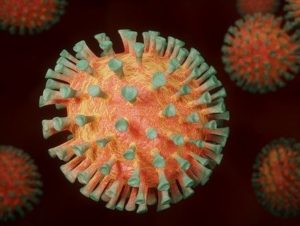Understanding Multisystem Inflammatory Syndrome in Children with COVID-19
Understanding Multisystem Inflammatory Syndrome in Children with COVID-19
April 16, 2021
Multisystem inflammatory syndrome in children (MIS-C) is a rare but is severe hyperinflammatory condition in children and adolescents. It is also known as pediatric inflammatory multisystem syndrome temporally associated with SARS-CoV-2. This typically occurs 2–6 weeks after acute SARS-CoV-2 infection. Symptoms include persistent fever, gastrointestinal issues, multiorgan inflammation, low blood pressure, high inflammatory markers, and a variety of other symptoms, including respiratory. Hospital admission has been explicitly included as a requirement in MIS-C case definition. Most patients are discharged after hospital admission for MIS-C, but approximately 60% of patients are admitted to intensive care unit (ICU) and approximately 2% die. The pathogenic mechanisms are not well understood but the delay between infection/exposure and onset suggests inappropriate innate immune responses elicited by infection, sometimes leading to a “cytokine storm”(1). A condition resembling MIS-C, called MIS-A, has been reported, but more rarely, in adults(2). It is not clear, however, that this condition is identical in its pathogenesis to MIS-C.

The most striking thing about MIS-C, besides its sudden onset in otherwise asymptomatic children, is how poorly it is understood. Even its relationship to COVID-19 is unclear; not all cases are PCR positive for SARS-CoV-2. In view of the delayed onset and the usually mild or inapparent symptoms in infected children, this does not necessarily exclude a previous infection. The strongest indication that SARS-CoV-2 is indeed the trigger is the temporal relationship between the onset of COVID-19 outbreaks in the general population and the appearance of cases of MIS-C. This has been observed in France(3), Italy(4), and the United Kingdom(5), with cases of MIS-C occurring 2-6 weeks subsequently to outbreaks.
Cytokine Storm and Kawasaki Disease
Inflammatory response in MIS-C differs from the cytokine storm of severe acute COVID-19 (6, 7). MIS-C shares several features with Kawasaki disease, but also differs from this condition with respect to T cell subsets, interleukin (IL)-17A, and biomarkers associated with arterial damage. MIS-C is marked by more severe lymphopenia, higher levels of the inflammatory markers C-reactive protein and ferritin, and lower platelet counts than is Kawasaki disease. Significantly elevated inflammatory cytokines include IL-6, IL-17A, and IL-18 and elevated chemokines include CCL3, 4, 20, and 28, and CXCL10. There are also reductions of subsets of natural killer (NK) and T lymphocytes. Multiple autoantibodies against self-antigens, such as La, an autoantigen typical of lupus, and Jo-1, seen in idiopathic inflammatory myopathies, are present. Thus, MIS-C appears to be both autoinflammatory and autoimmune in nature. Interestingly, treatment with IL-6R antibody or IV immunoglobulin (IVIG) has led to disease resolution(7). Other treatments commonly used include IL-1RA or high dose of steroids.
The most striking thing about MIS-C, besides its sudden onset in otherwise asymptomatic children, is how poorly it is understood. Even its relationship to COVID-19 is unclear; not all cases are PCR positive for SARS-CoV-2.
MIS-C shares several features with Kawasaki disease, but also differs from this condition with respect to T cell subsets, interleukin (IL)-17A, and biomarkers associated with arterial damage.
One of the difficulties in investigating MIS-C is that infection with SARS-CoV-2 is usually mild or asymptomatic in children. Therefore, by the time MIS-C becomes apparent, the infection has resolved, and the early events have already passed.
Identifying MIS-C
One of the difficulties in investigating MIS-C is that infection with SARS-CoV-2 is usually mild or asymptomatic in children. Therefore, by the time MIS-C becomes apparent, the infection has resolved, and the early events have already passed. The analysis of the U.S. Centers for Disease Control and Prevention (CDC) MIS-C database has identified many potential explanatory factors and outcomes (8). Specifically, age older than 5 years was strongly associated with more severe outcomes, and non-Hispanic Black children also seem to be more affected than non-Hispanic White children. Patients reporting shortness of breath or abdominal pain were more likely to be admitted to an ICU, compared with those without these symptoms. Consistent with patients with non-SARS-CoV-2-related sepsis, increased concentrations of troponin, B-type natriuretic peptide (BNP), and proBNP were strongly indicative of ICU admission, shock, and decreased cardiac function. These results might have important clinical utility in identifying which patients presenting to the emergency department or admitted to the general ward are likely to have severe outcomes during their admission. However, further studies will be required to identify patients at risk by defining the associations between the laboratory markers and clinical outcomes.
- H. Rowley, Understanding SARS-CoV-2-related multisystem inflammatory syndrome in children. Nat Rev Immunol 20, 453-454 (2020).
- S. B. Morris et al., Case Series of Multisystem Inflammatory Syndrome in Adults Associated with SARS-CoV-2 Infection – United Kingdom and United States, March-August 2020. MMWR Morb Mortal Wkly Rep 69, 1450-1456 (2020).
- A. Belot et al., SARS-CoV-2-related paediatric inflammatory multisystem syndrome, an epidemiological study, France, 1 March to 17 May 2020. Euro Surveill 25, (2020).
- F. Sperotto et al., Cardiac manifestations in SARS-CoV-2-associated multisystem inflammatory syndrome in children: a comprehensive review and proposed clinical approach. Eur J Pediatr 180, 307-322 (2021).
- P. Davies et al., Intensive care admissions of children with paediatric inflammatory multisystem syndrome temporally associated with SARS-CoV-2 (PIMS-TS) in the UK: a multicentre observational study. Lancet Child Adolesc Health 4, 669-677 (2020).
- C. R. Consiglio et al., The Immunology of Multisystem Inflammatory Syndrome in Children with COVID-19. Cell 183, 968-981 e967 (2020).
- C. N. Gruber et al., Mapping Systemic Inflammation and Antibody Responses in Multisystem Inflammatory Syndrome in Children (MIS-C). Cell 183, 982-995 e914 (2020).
- Abrams J, Oster M, Godfred-Cato S, et al. Factors linked to severe outcomes in multisystem inflammatory syndrome in children (MIS-C) in the USA: a retrospective surveillance study. Lancet Child Adolesc Health. doi:10.1016/s2352-4642(21)00050-x
